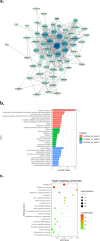Effect of Oroxylum indicum on hepatocellular carcinoma via the P53 and VEGF pathways based on microfluidic chips
- PMID: 37936097
- PMCID: PMC10629109
- DOI: 10.1186/s12906-023-04217-z
Effect of Oroxylum indicum on hepatocellular carcinoma via the P53 and VEGF pathways based on microfluidic chips
Retraction in
-
Retraction Note: Effect of Oroxylum indicum on hepatocellular carcinoma via the P53 and VEGF pathways based on microfluidic chips.BMC Complement Med Ther. 2025 Jan 25;25(1):26. doi: 10.1186/s12906-025-04776-3. BMC Complement Med Ther. 2025. PMID: 39863838 Free PMC article. No abstract available.
Abstract
Background: Hepatocellular carcinoma (HCC), abbreviated as liver cancer, is one of the most common cancers in clinics. HCC has a wider spread and higher incidence due to its high malignancy and metastasis. In HCC, effective strategies to block cancer cell migration, invasion, and neovascularization need to be further studied. Consumption of flavonoid-rich Oroxylum indicum (OI) has been associated with multiple beneficial effects, including anti-inflammatory and anticancer properties, but the potential effects on HCC have not been thoroughly investigated.
Objective: In this study, we aimed to reveal the effect of OI on HCC and its potential mechanism through microfluidic technology.
Methods: We designed microfluidic chips for cell migration, invasion, and neovascularization to evaluate the effect of OI on HepG2 cells. To further explore the mechanism of its anti-liver cancer action, the relevant signaling pathways were studied by microfluidic chips, RT‒qPCR and immunofluorescence techniques. Compared to the control group, cell migration, invasion, and angiogenesis were significantly reduced in each administration group. According to the P53 and VEGF pathways predicted by network pharmacology, RT‒qPCR and immunofluorescence staining experiments were conducted.
Results: The results showed that OI upregulated the expression of Bax, P53 and Caspase-3 and downregulated the expression of Bcl-2 and MDM2. It has been speculated that OI may directly or indirectly induce apoptosis of HepG2 cells by regulating apoptosis-related genes. OI blocks the VEGF signaling pathway by downregulating the expression levels of VEGF, HIF-1α and EGFR and inhibits the migration and invasion of HepG2 cells and the formation of new blood vessels.
Conclusion: Our findings suggest that OI may inhibit the migration, invasion, and neovascularization of HepG2 cells, and its regulatory mechanism may be related to the regulation of the P53 and VEGF pathways.
Keywords: Anti-liver cancer; HUVEC; HepG2; Microfluidic chip; Oroxylum indicum.
© 2023. The Author(s).
Conflict of interest statement
The authors declare no competing interests.
Figures














References
-
- Sharma SA, Kowgier M, Hansen BE, Brouwer WP, Maan R, Wong D, Shah H, Khalili K, Yim C, Heathcote EJ, Janssen HLA, Sherman M, Hirschfield GM, Feld JJ. Toronto HCC risk index: A validated scoring system to predict 10-year risk of HCC in patients with cirrhosis. J Hepatol. 2017; 10.1016/j.jhep.2017.07.033. - PubMed
-
- Siegel RL, Miller KD, Wagle NS, Jemal A. Cancer statistics, 2023. CA Cancer J Clin. 2023; 10.3322/caac.21763. - PubMed
-
- Giannini EG, Farinati F, Ciccarese F, Pecorelli A, Rapaccini GL, Di Marco M, Benvegnù L, Caturelli E, Zoli M, Borzio F, Chiaramonte M, Trevisani F; Italian Liver Cancer (ITA.LI.CA) group. Prognosis of untreated hepatocellular carcinoma. Hepatology. 2015; 10.1002/hep.27443.
Publication types
MeSH terms
Substances
Grants and funding
LinkOut - more resources
Full Text Sources
Medical
Research Materials
Miscellaneous

